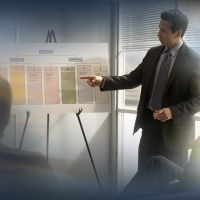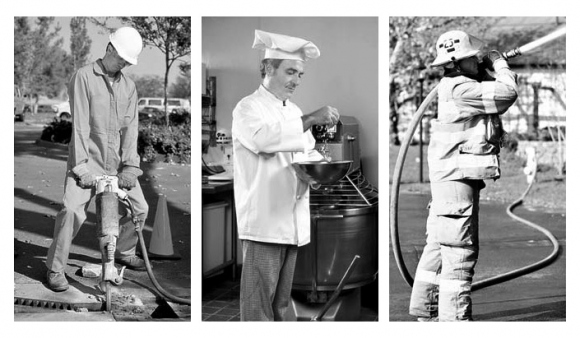The org board shows the pattern of organizing to obtain a product.
A board then is a flow chart of consecutive products brought about by terminals in series.
We see these terminals as “posts” or positions.
Each one of these is a hat.
The term hat is slang for the title and work of a post in an organization. It is taken from the fact that in many professions such as railroading the type of hat worn is the badge of the job. For example, a train crew has a conductor who wears a conductor’s hat—he has charge of the passengers and collects fares.
In an organization, there is a flow along these hats.
The result of the whole board is a product.
The product of each hat on the board adds up to the total product.
Working It Out
The waste of people involved in no org board and the loss of product justify any amount of effort to work out, make known and use a proper org board.
Man instinctively uses an org board and protests the lack of one. The rawest recruit walking aboard a ship assumes the existence of an org board, if not a posted one, at least a known one. He assumes there will be somebody in charge and that different activities will be under different people. When there is no known org board he protests. He also feels insecure as he doesn’t know where he fits into this organization.
Almost all revolts are manned by people who have been excluded out and are not on the country’s org board. This is so true that a ridiculous circumstance occurred in the US. A president found he had “professional
The effort to belong or to be part of is expressed by an org board. A person with no post is quite miserable. A person with an unreal post feels like a fraud or a mistake.
Morale then is also considerably affected by the quality of an org board or its absence.
The overall test for the group, however, is its viability, which means its ability to grow, expand, develop, etc. Viability depends on having an acceptable product. Groups which do not have an acceptable product are not likely to survive.
The volume and acceptability of a product depends in no small measure on a workable, known org board. This is true even of an individual product.
An individual or small group, to get anywhere at all, requires a very exact org board. The oddity is that the smaller the group the more vital the org board. Yet individuals and small groups are the least likely to have one. Large groups disintegrate in the absence of an org board and go nonviable in the presence of a poor one.
The quality of a product, usually blamed on individual skill only, depends to an enormous extent upon the org board. For example, one disorganized mob that was trying to make a certain product was worked to death, harassed, angry at one another and had a wholly unacceptable product at about twice the usual cost; when organized to the degree of a third, still without proper schedules, still largely untrained, they began to turn out an acceptable product at about half the effort—so even some organization worked.
The product volume and quality depends utterly and totally upon the org board and hats and their use. You can train individuals endlessly but unless they are operating on a workable org board they will still have a poor or small volume product.
Lack of a known and real org board can spell failure. And lack of knowledge of the subject of organization has to be substituted for by pure genius at every point.
Thus to make anything at all, to improve any product, sustain morale and distribute work equitably and make it count, one has to have a real and a known org board.
So how do you make one?
Hats
An org board is made up of hats.
The definition of a hat is the “
Let us take a train:
The engineer wearing his engineer hat has the title of engineer. That’s the beingness.
He accepts orders, watches signals and general conditions, operates levers and
He safely and on schedule moves the train passengers and/or freight from one location to another. A moved train and load is the product.
So how do we find out there is a hat called engineer?
As people are continually accepting or viewing already existing posts, when you ask them to dream up an org board they at first may not realize that you are asking them to invent the correct posts.
They don’t have to invent “engineer.” Everybody knows “an engineer runs a train.”
So if you didn’t know this? You’d have to figure it out.
One would do it this way. One would have to think along these lines:
The idea comes about because of a concept that people and goods have to be moved over distances on land. Or that a new area building up has to have transport of people and goods from and to it.
Ah. This will be viable in an economic framework because people will pay to be moved and pay for their goods to be moved.
Trains do this.
So let’s use trains.
Arranging finance (or by prepayment) and obtaining a
Now it emerges that somebody has to drive the train. So somebody had better be hired to drive the train.
So there comes into view the post of engineer.
How do we know this? Because we have to have a product of moved people and goods. That was what we were trying to do in the first place.
Therefore, the engineer hat.
So supposing now we did not have any org board at all.
The engineer hat would be the only hat. So he collects fares, runs stations, fixes his engine, buys fuel, loads the cars, sells
Wait a minute. If the engineer did all that the following would happen:
1. He would be exhausted.
2. His temper would be bad.
3. He would have machinery breakdowns.
4. He might have wrecks.
5. The railroad property otherwise unhandled would disintegrate.
6. He would have a low volume of product.
7. His product would be uneven and bad as he could maintain no schedule.
8. There would shortly be no railroad.
Now let’s “solve” this as it has been done in the past.
Let’s appoint a person for each station and say “There we are!”
Well, it would still be a mess.
So let’s hire more engineers and more
No, we have to solve this in quite another way.
We do not get anywhere and we will not get a sensible org board and nothing will work or be viable unless WE COUNT THE PRODUCTS CORRECTLY AND DEVELOP HATS TO ATTAIN THEM.
When we have done this we can arrange the hats on an org board so there is a flow and command channels and communication channels and we’ve got an org board.
You cannot work out an org board until you have counted products!
As volume increases you estimate the products before the final product and hat those.
Quality of final product depends on a real org board and hats, both complete, real and trained-in and the functions DONE.
Let us see now how you break down a final product into the products which, put together, comprise it.
We have the final product of a railroad—viably moved loads. How many lesser products go into the big product?
There is a matter of machinery here. Any machine has two products: (a) the machine itself in good operating condition, (b) the product of the machine. A repairman and machine shop man and a repair shop keeper each has a product under (a). That is just for the machine, the engine.
Under (b) we have what the machine itself produces (hauled trains in the case of an engine).
Here we have then two major products—and these break down into lesser products, earlier in sequence to the final product.
There is even an earlier product to these—bought engines. And an earlier product to that—finance for equipment.
As for the load itself, a delivered load, accepted at the receiving end by a
Each one of these products is a hat.
Surveying this again we see there’s no charges or income involved so no economic viability. Thus there is an additional product, the income which is necessary for the organization’s survival to pay its bills, buy the
Someone has to have a desirable product that is sold for more than it costs to produce and has to sell it and deliver it to have income.
Even in
goods or money given by a government agency to people because of need or poverty.
condition or state of being; existence. Beingness also refers to the assumption or choosing of a category of identity. Beingness can be assumed by oneself or given to oneself or attained. Examples of beingness would be one’s own name, one’s profession, one’s physical characteristics, one’s role in a game—each or all of these could be called one’s beingness.
the performance of some action or activity.
any device in a pipe or tube that regulates the flow of a liquid or gas. For example, a tube carrying fuel to an engine would have a valve for regulating how much fuel is going to the engine.
a right or privilege officially granted to an individual or a company by some authority such as a government.
a narrow length of land used for the route of a railroad.
1. ownership in a corporation or company in which someone has bought shares (equal parts into which stock of a company has been divided). Stock entitles the buyer to share in the ownership of the company and usually results in money paid to shareholders, voting rights, etc. 2. a supply of items used so frequently that they are kept available on a regular basis. 3. have an item available for sale.
a person on duty at a railroad station, responsible for passengers or freight.
a person to whom something has been consigned, delivered to or addressed to.
obtained or acquired.
that with which to do something; means or supplies for the purpose or need.
an economic system in which the production and distribution of goods are controlled by the government rather than by individuals.
the political theory or system in which all property and wealth is owned in a classless society by all the members (workers) of a community. It enforces extensive negative controls on personal liberties and freedom and collective needs of the masses overrule individual rights.

